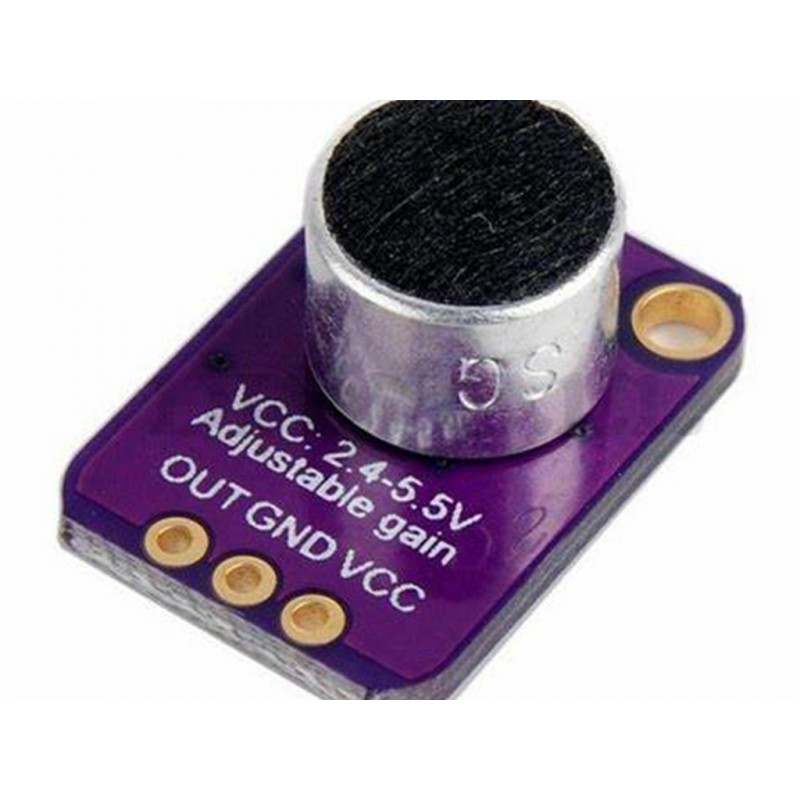-MAX4466 Electret Microphone Amplifier with Adjustable Gain Module is fully assembled; tested board comes with a 20-20KHz electret microphone soldered on.
-For the amplification, we use the Maxim MAX4466, an op-amp specifically designed for this delicate task; The amplifier has excellent power supply noise rejection, so this amplifier sounds really good and isn’t nearly as noisy or scratchy as other mic amp breakouts we’ve tried!
-This MAX4466 Electret Microphone Amplifier with Adjustable Gain Module is best used for projects such as voice changes; audio recording/sampling, and audio-reactive projects that use FFT.
-On the back, we include a small trimmer pot to adjust the gain.
-You can set the gain from 25x to 125x.
-That’s down to be about 200mVpp (for normal speaking volume about 6″ away) which is good for attaching to something that expects ‘line level’ input without clipping, or up to about 1Vpp, ideal for reading from a microcontroller ADC.
-The output is rail-to-rail so if the sounds get loud, the output can go up to 5Vpp.
How to Use:
-Connect GND to ground, VCC to 2.4-5VDC.
-The audio waveform will come out of the OUT pin.
-The output will have a DC bias of VCC/2 so when its perfectly quiet; the voltage will be a steady VCC/2 volt (DC couple).
-If the audio equipment you’re using requires AC coupled audio; place a 100uF capacitor between the output pin and the input of your device.
-If you’re connecting to an audio amplifier that has differential inputs or includes decoupling capacitors; the 100uF cap is don’t require.
-The output pin is not designed to drive speakers or anything but the smallest in-ear headphones- you’ll need an audio amplifier (such as 3.7W stereo amp)
-If you want to connect the amp directly to speakers.
-If you’re connecting to a microcontroller pin, you don’t need an amplifier or decoupling capacitor; connect the OUT pin directly to the microcontroller ADC pin.
-For audio-reactive projects; we suggest using an FFT driver library which can take the audio input and ‘translate’ it into frequencies.
Features:
-+2.4V to +5.5V Supply Voltage Operation.
-Versions with 5nA Complete Shutdown Available (MAX4467/MAX4468).
-Excellent Power-Supply Rejection Ratio: 112dB.
-Excellent Common-Mode Rejection Ratio: 126dB.
-High AVOL: 125dB (RL = 100kΩ).
-Rail-to-Rail Outputs.
-Low 24µA Quiescent Supply Current.
-Gain Bandwidth Product:
-200kHz (MAX4465/MAX4467/MAX4469)
-600kHz AV ≥ 5 (MAX4466/MAX4468)
-Available in Space-Saving Packages
-5-Pin SC70 (MAX4465/MAX4466)
-8-Pin SOT23 (MAX4467/MAX4468/MAX4469)
| SPECIFICATIONS: |
|
| Model |
MAX4466 |
| Input
Voltage (Volt) |
2.4 – 5.5 |
| Input
Current (µA) |
24 |
| Gain
Bandwidth Product |
600(KHz) |
| Phase
Margin (Degrees) |
70 |
| Gain
Margin (dB) |
20 |
| Shipment Weight |
0.078 kg |
| Shipment Dimensions |
10 × 5 × 3 cm |
OVERVIEW:
-Supply Voltage Operation:+2.4V to +5.5V.
-Versions with 5nA Complete Shutdown Available only (MAX4467/MAX4468).
-Excellent Power-Supply Rejection Ratio: 112dB.
-Excellent Common-Mode Rejection Ratio: 126dB.
-High AVOL: 125dB (RL = 100kΩ).
PACKAGE INCLUDES:
1 PCS x Max4466 Electret Microphone Amplifier With Adjustable Gain Module
https://www.maximintegrated.com/en/products/analog/audio/MAX4466.html
//SOURCE CODE TAKEN FROM BELOW LINK
//http://arduinolearning.com/code/arduino-and-max4466-electret-module-example.php
const int sampleWindow = 50; // Sample window width in mS (50 mS = 20Hz)
unsigned int sample;
void setup()
{
Serial.begin(9600);
}
void loop()
{
unsigned long startMillis= millis(); // Start of sample window
unsigned int peakToPeak = 0; // peak-to-peak level
unsigned int signalMax = 0;
unsigned int signalMin = 1024;
// collect data for 50 mS
while (millis() - startMillis < sampleWindow)
{
sample = analogRead(A0);
if (sample < 1024) // toss out spurious readings
{
if (sample > signalMax)
{
signalMax = sample; // save just the max levels
}
else if (sample < signalMin)
{
signalMin = sample; // save just the min levels
}
}
}
peakToPeak = signalMax - signalMin; // max - min = peak-peak amplitude
double volts = (peakToPeak * 5.0) / 1024; // convert to volts
Serial.println(volts);
}
 9962060070
9962060070
